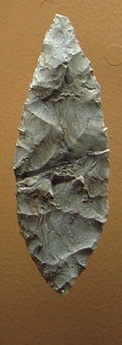The mastodon, that huge elephant-like creature that symbolizes the Ice Ages for many of us, is once again part of an archeological controversy concerning the origin of native Americans.
Before their extinction about 10,000 years ago, mastodons roamed North America for about 2 million years. Missouri was no exception. In fact, when Albert Koch, Ph.D. unearthed a nearly complete skeleton in the 1840’s for display in his St. Louis Museum, he named it “Missourium.”

The site that Koch dug near Kimmswick has yielded many more mastodon skeletons, as well as the bones of other ice-age ‘mega-fauna’ such as giant sloths, giant beavers, and dire wolves. But the discovery by Russell Graham in 1980 of a carefully crafted stone spear-point touching a mastodon bone caused that site to be preserved as Mastodon State Historic Site.
“Our great grandfathers in archeology claimed that no humans were in America during the Ice Age,” says Michael Fuller, professor of Archeology at St. Louis Community College, Meramec. Russell had found the first definitive proof that man and mastodon co-existed during the ice age, just as a similar discovery about 50 years earlier in Clovis, New Mexico, proved the coexistence of man and wooly mammoths.

Photo courtesy of Virginia Department of Historic Resources.
From these and subsequent similar finds all over the continent came the “Clovis-first” theory of new world population.
“Clovis-first” says that the ancestors of modern native Americans were able to cross the Bering Straits from east Siberia on land during a period when most of the earth’s water was frozen, causing the sea level to decrease 300 feet. The Clovis people were thought to be nomadic big-game hunters, who spread their culture over the Americas within a few hundred years. Their civilization lasted from about 13,200 to 12,900 years ago.
For some years in the late 1900’s, the Clovis-first theory seemed to account for all the known facts. Most significantly, DNA analysis showed that all living Native Americans showed the same genetic markers as ancient skeletons from an area of eastern Siberia.
But as archeologists kept digging, new evidence emerged showing that modern man inhabited the Americas before the Clovis civilization. Sites in South American, especially Monte Verde, Chile, were clearly older by at least one thousand years. The people who lived there may have travelled from Siberia down the western coast by boat. Unfortunately, no boat of that age has yet been found.
Even more convincing, fossilized human feces found in an Oregon cave has been carbon-dated as 14,300 years old. These “coprolites” yielded enough DNA to show that these ancient humans were of groups common in eastern Asia and Siberia. No implements were found in that site, however
Now a new book, “Across Atlantic Ice” by Smithsonian anthropologist Dennis Stanford and British archeologist Bruce Bradley, hypothesizes that the first Americans actually arrived by boat from Europe 20-22,000 years ago. Again, a mastodon plays a prominent role in this “Solutrean” hypothesis.
In 1970, fishing boat in Chesapeake Bay hauled up a mastodon tusk. In the same net was a stone spearpoint, still sharp. The tusk was carbon dated as 22,000 years old. Perhaps the spear was just as old.

Photo courtesy of World Imaging.
Further digging in the Chesapeake Bay area yielded more stone tools. The tools could not of course be carbon dated, but the soil from which they came was dated at about 20,000 years old.
“Across Atlantic Ice” hypothesizes that the stone implements were left by Solutreans who crossed the Atlantic by boat from France and Spain. The Solutreans, who created the art in the Lascaux and Altamira caves, were known to make stone tools somewhat similar to the Clovis points. That is, both are thin, and flaked on two sides to create a sharp edge. Perhaps they passed on their technology to Clovis progenitors. Fuller finds some parallels between Solutrean and Clovis technology, but not enough to be convinced of a relationship.
Unfortunately, no human remains have been found from this time period. Since genetic markers typical of Europeans are not found in living native Americans, the only connection is in stone. “Human remains would be the smoking gun, “ says Fuller. “Maybe that hyper-convincing evidence is only a dig away.”
It is not, of course, difficult to imagine that organic material 3-4000 years older than the earliest dated site in the Americans might be hard to find. Solutrians may have inhabited the continent for millennia and then left or died out—or not.
In fact, so far the Clovis culture has not yielded human remains from which DNA can be extracted. (The Oregon coprolites are too old to technically be called Clovis.)
Mastodon State Historic Site in Kimmswick was a killing ground. Many of the animal bones have tool marks showing that they were butchered and presumably the meat removed. Ken Smith, natural resource manager at the park, says that the there were ponds and streams in the area, making it a gathering place for animals and their hunters. “It is easier to hunt a 4-6 ton mastodon when its head is down and is feet sunk in the mud than to chase one on dry ground.”

There is no evidence of Clovis people actually living at the site. Brooke Mahar, interpretive resource specialist, points out that “we can only use the data we have. We know the environment at the site because we have pollen preserved, for example. But because these were nomadic peoples, they didn’t leave glorious structures to look at. They didn’t alter the environment, like the mound builders at Cahokia 10,000 years later.”
The site did continue to be a hunting ground past the ice age, and well past the disappearance of the mega-fauna like mastodons. The park museum displays stone tools from the area used from Clovis times to Mississippian (800-1500 AD).
Other exhibits at the museum include the cast of the mastodon skeleton shown in the photo, and a diorama showing ice age people and some of the animals they hunted. Visitors can walk down to the bone bed. A movie, made just a few years ago, discusses the theories of the origin of native Americans, including the Solutrean hypothesis. “But we don’t subscribe to any single theory here” says Smith, “since nothing has been proved.”
Adds Mahar, “Pre-history is not something that happened somewhere else. It is right here in Missouri.”
Mastodons and wooly mammothsThey lived at the same time, and on the same continent. Both resembled elephants. But mastodons and wooly mammoths were different species. Wooly mammoths (family Elephantidae) were closely related to elephants. They lived in grasslands; remains have been found on the western side of Missouri. Mastodons (family Mammutidae) split off from their mutual ancestor early. A bit smaller than the wooly mammoth, mastodons lived in forested areas and were adapted to eating trees. Many mastodon remains have been found in eastern Missouri.
Mass extinctionBetween 10 and 12,000 years ago, many large mammals native to North America disappeared forever from the earth. Aside from mammoths and mastodons, two species of giant ground sloth, the dire wolf, the sabertooth cat, the American western camel, and others all became extinct in a short period of geologic time. Theories abound to explain the mass extinction of these ‘mega-fauna.’ Perhaps an asteroid caused massive climate change, although the crater has not been found. Perhaps a pandemic occurred. Clovis tools were relatively sophisticated, and the mass extinction so coincident with their culture that many believe the Clovis hunters actually wiped out their prey.
This article was originally published in the St. Louis Beacon.
